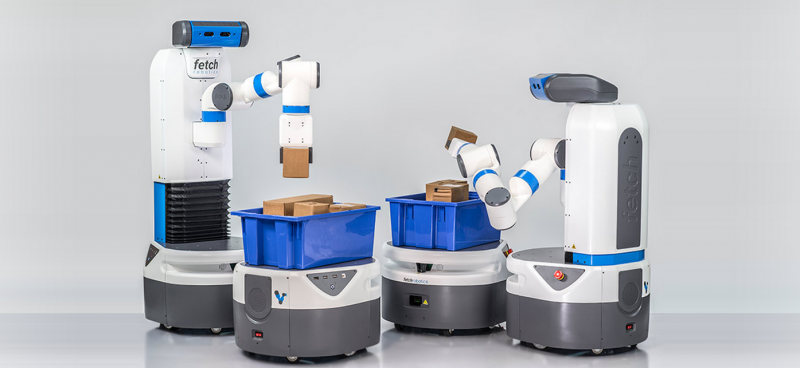April 30, 2015 weblog
Warehouse robots Fetch, Freight aim to ease fulfillment burdens

Fetch Robotics on Wednesday officially introduced its robotics system for the logistics industry. Melonee Wise, CEO, Fetch Robotics, had an impressive story to tell about what her company has done to support warehouse work.
As IEEE Spectrum reminded its readers, warehouse robot design, in attempting efficiency and cost-effectiveness, is not anywhere near easy. One attempts to design robots for structured environments but with "an enormous amount of variability in products to be picked, long distances to traverse, aggressive uptime requirements," and avoiding accidents," but the difficulty of such an attempt did not deter Fetch Robotics from going ahead with its two-robot solution.
San Jose-California-based Fetch Robotics has a pair of robots, Fetch and Freight, that can autonomously pick and deliver goods in a warehouse.
The two are a manipulator and base. One robot picks items from shelves while the other can take items around. Fetch and Freight can be used to collaborate to fulfill orders. Fetch can select the items from the shelf, while Freight provides quick transit through the warehouse. Both can recharge themselves autonomously. A charging dock allows the robots to charge when needed and then continue on with their tasks. The system includes accompanying software.
Why two robots as a pair? "The reason we're doing two robots," said Wise in IEEE Spectrum, " is because one of the big challenges in logistics is traversal of the warehouse. A mobile manipulator just can't move as fast because it has a high center of gravity, and so we need a smaller, faster robot to zip around the warehouse and get stuff done. Because at some point, we have to be as fast as people, or faster."
The bigger robot, a mobile manipulator, is Fetch, and it picks items off shelves. The smaller robot, Freight, is a mobile base which behaves as an autonomous cargo delivery cart.
The little Freight robot can be paired with a human as a co-worker, to help the human shelf picker pull items off shelves to fulfill shopping orders. MIT Technology Review recounted how she approached a row of shelves packed with goods in one corner of her workshop, while "a squat, wheeled robot carrying a plastic crate" glided along behind. A worker gathers items from shelves and tosses items into the robot's carried crate. "When an order is complete, a tap on a smartphone commands the robot to scoot its load off to its next destination," said Tom Simonite in MIT Technology Review.
According to the Fetch Robotics site, "Once a worker has selected that Freight follow them, the robot will 'pair' with the worker. Freight can then follow the worker throughout the environment, providing a bin or shelf that is always within arm's reach. Once a pick list has been satisfied, Freight can autonomously return to pre-designated packing and shipping locations. Additional Freight can be automatically and autonomously deployed to the worker's current location, ensuring maximum warehouse throughput."
As for monitoring and statistics, each robot can communicate metrics and data back to a central fleet server. "A web-based front end allows warehouse floor managers to get real-time access to where robots and workers are, how orders are being fulfilled, and inventory status. Custom graphs and charts can be added to the dashboard to highlight important metrics or data," said the robotics team.
Freight has a payload support of approximately 68 kgs. The bigger Fetch can rove around shelving and take down items and drop them into the Freight robot's crate. IEEE Spectrum said the grasping range is all the way from the floor up to just under two meters, covering approximately the same manipulation range as a human. The back-drivable arm of Fetch has seven degrees-of-freedom. It can lift approximately six kilograms. As for safety, it is low power enough to be safe for humans, and its software includes the ability to detect any collisions and stop the arm.
Evan Ackerman in IEEE Spectrum listed its other details: a PrimeSense 3D sensor in its head, which can pan and tilt, and mounting points for additional sensors. The base of Fetch has a charging dock, 25-meter range navigation and obstacle avoidance laser from SICK and differential drive.
MIT Technology Review reported that a dozen companies are working with the company to test out the idea and "humans will be teaming up with Freight robots in real warehouses in the next few months." IEEE Spectrum reported that Wise seemed confident that Fetch Robotics will be able to ship both of their robots in Q2 of this year.
The robots will be on display at ICRA, the IEEE Robotics and Automation Society's conference next month in Seattle.
As for the cost of these robots, exact pricing was unavailable at this time. Both robots are built upon the open source robot operating system, ROS.
More information: fetchrobotics.com/2015/04/fetc … -logistics-industry/
© 2015 Tech Xplore

















